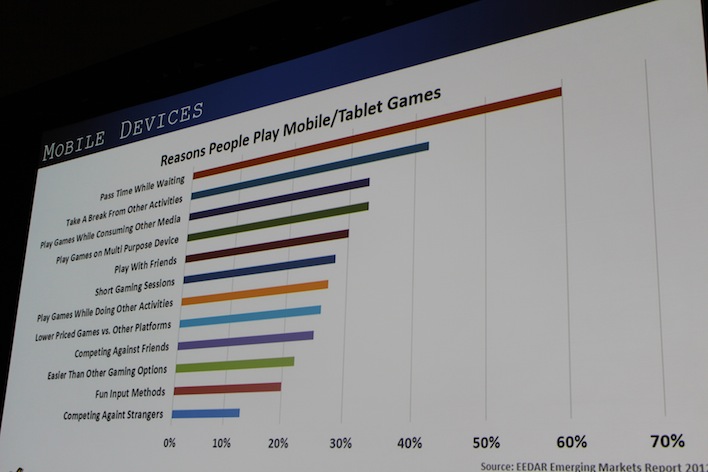SAN FRANCISCO — After looking at a bunch of data points, the gaming community needs to realize three things: Ladies and old people love games; reviews really do dictate your sales; and your game is good — but marketing will make it even better.
Video game research firm EEDAR revealed its latest findings today at the Game Developers Conference and the results may delight and disappoint you.
Let’s start with the delight.
 The ladies, and your grandparents, love gaming, too
The ladies, and your grandparents, love gaming, too
It seems a little obvious. Of course women are interested in gaming, but the numbers increasingly support this. According to EEDAR’s research, adult women now represent 30 percent of the gaming population. That’s more than the 17-and-younger boys segment.
The amount of female and, in fact, elderly players has significantly increased with the introduction of the smartphone. Indeed, since the smartphone was released, we have nearly reached an equilibrium between 18 and younger players, 19-49 players, and 50-plus players.
Mobile games have done more than bring new types of players into the pastime. They’ve also changed the reason we play games. Overwhelmingly, 60 percent of people who play mobile games do it simply to pass the time. It has moved from an individual activity that you did in your living room and has expanded into the broader world.
“We basically have a gaming device in every single pocket,” said Geoffrey Zatkin, a researcher at EEDAR. “It’s now social acceptable to play games anywhere.”
Got a bad review? Sorry, that really does suck and might affect your bottom line
Unfortunately, that 1-100 review score your game gets really does have an affect on your sales. EEDAR’s study found that games in the 90-100 review-score range sold many more copies than those who scored in any other levels of reviews. Looking at games only released through from each platform’s launch through December 2012 for the PlayStation 3, the Xbox 360, and the Wii, EEDAR found that only 72 games made it into the 90-100 range. Those games grossed an average of 1,123,000 units sold in their first three months on sale. That’s compared to 454 games that scored an 80-89 review that grossed an average of 449,000 units sold in their first three months.
That’s 382 more games that sold an average of 674,000 fewer units in the same time frame.
EEDAR did a study of three groups of gamers playing PopCap’s casual game, Plants vs. Zombies. They paid everyone $10 apiece and asked each group to read a set of reviews before playing the game — one group read good reviews, one read bad reviews, and the other read a mix (the control group). The results were as expected. Those that read the good reviews all ranked Plants vs. Zombies higher in their own reviews versus the control group and versus the “bad reviews” group.
It got interesting, however, when EEDAR asked each group if they’d rather take the game instead of the payment. Those in the positive group took the game in far greater numbers than those in the negative group, showing that reviews really do affect whether someone is willing to “spend” on a game.
But despite the need to make a really great game, your marketing budget and the timing of your game’s release really could really make the different between a hit and a flop.
 Marketing, marketing, marketing = money, money, money
Marketing, marketing, marketing = money, money, money
So, you’re about to release a game. You’d better start considering the buzz you want to generate. You have a few ways of doing this: Getting covered in a magazine (see all that review data up there) or a website and buying advertising.
If your game got a bad review, marketing should be your next biggest push.
“Marketing is basically steroids for your games,” said Zatkin.
But marketing is dominated by the big guys — at least in terms of advertising. Over the past few years, Call of Duty has dominated “pop advertising,” or those advertisements you see when you walk into a game store. In 2012, Assassin’s Creed III and Madden NFL 13 also topped the charts in pop advertising positions. But that’s because these games all have huge publishers and big marketing budgets.
How does the little guy get in there? By getting editorial mentions. This can also be a challenge, however. From 2010 to 2012, shooter games dominated the cover-spots on major gaming magazines. Indeed, 53 percent of games featured on magazines were shooters in this time period.
Regardless, marketing is crucial.
He explained in the chart to the right that if you both get great reviews and spend a lot on market, your games are going to sell that much better. If you have low reviews and don’t spend all that much, you’re going to do poorly in sales. But that’s obvious. What about if you compare getting poor reviews and spend lots of marketing money, or the inverse, you spend little money on marketing and get great reviews? Turns out, marketing always wins. If you spend the marketing cash, you are statistically more likely to sell better on the PlayStation 3, Wii, and Xbox 360.
Photos via Meghan Kelly/VentureBeat
VentureBeat's mission is to be a digital town square for technical decision-makers to gain knowledge about transformative enterprise technology and transact. Learn More

